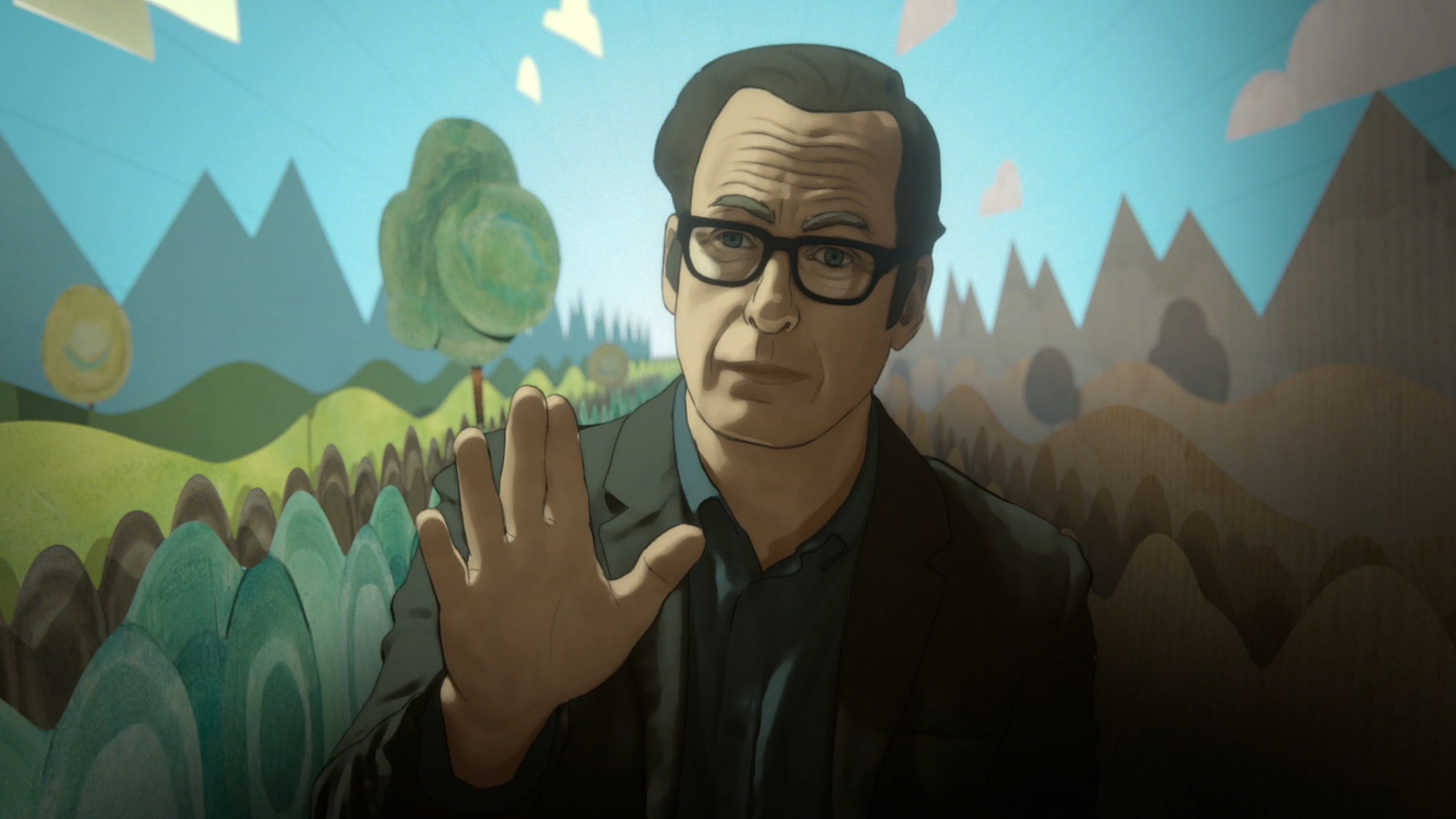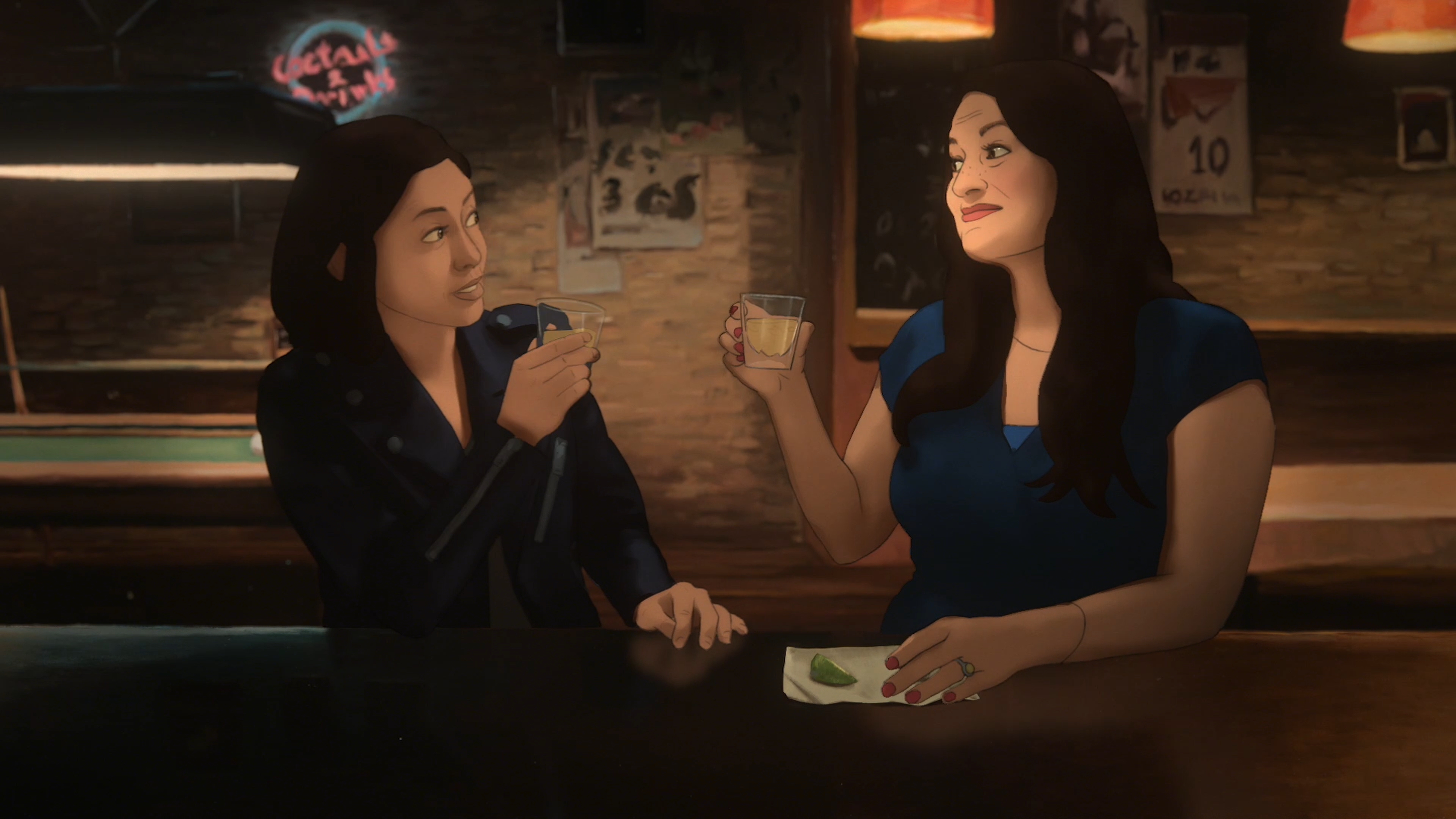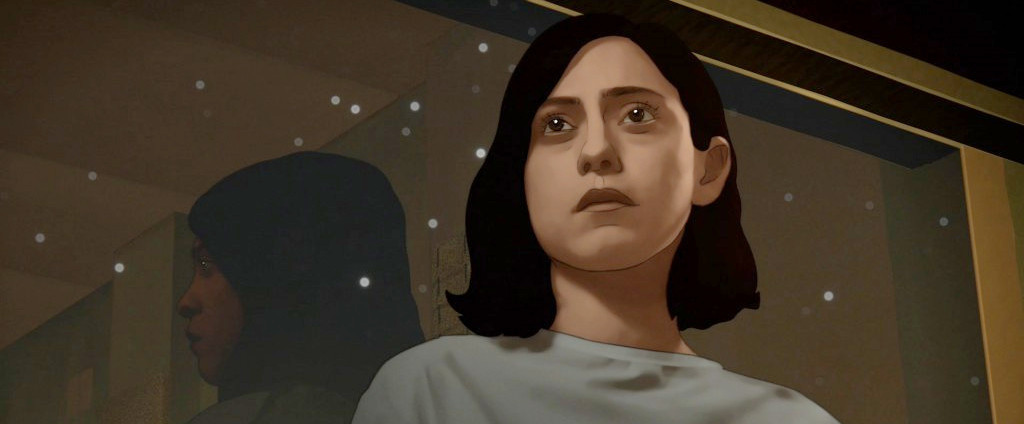BoJack Horseman creator Raphael Bob-Waksberg and writer Kate Purdy aim to take fans on mind-bending journey with their latest adult-animated series, Undone. The eight-episode Amazon drama, starring Rosa Salazar and Bob Odenkirk, follows the journey of Alma, a young woman involved in a car accident who slowly begins to lose her mind. She’s forced to question her perception of reality when her father (Odenkirk) reappears years after his death, pushing her to discover how he died and why she seems to have a newfound ability to travel through time.
The show’s a bit of a mindf*ck, in the best possible way, with Purdy and Waksberg employing rotoscoping, a realistic animation technique never before used on TV, to take viewers on a surreal trek through space and time, along with dark humor and musings on grief, trauma, and mental health. We chatted with the creators about breaking ground with the Amazon series, mining humor from mental illness, and how the show shares ties with their popular Netflix comedy.
When did you have this idea for the show?
Kate Purdy: [In] Season one of BoJack, I wrote this episode called “Downer Ending,” in which BoJack has this drug trip and he experiences an alternate reality of a life he could have lived if he had made less selfish choices. And after that Raphael approached me and said, “We should do a show that’s like this that explores alternate realities or perceptions of reality.” So, I talked to him about some of my life experiences. I had come out of a deep depression. I had anxiety; I had a big life transformation where I sought out different kinds of alternate healing modalities. And through that meditation and traditional Chinese medicine, I had gained a lot of what I felt to be wisdom that helped me understand reality and a new way to think. My grandmother had schizophrenia. I never met her. So I had always worried about my mental health and the potential of losing my mind and now was having that experience of losing my mind and not knowing if I’d ever regain it, but, then to find these different healing modalities and to come through it and to realize that in other cultures, the people who have visions or hear voices or feel lost are often people who become the wise ones, the ones who are in touch with something beyond the veil. So, the question is this: “Is this really happening to me or not? Is this just a great gift or is this the ultimate form of narcissism, of making myself feel like I have importance?” We talked about this character, Alma, having some of these similar experiences and what that would look like, how it would feel, how would it manifest, and help shine a light on different perceptions of reality and the fact that really none of us holds the truth. Maybe the truth is larger than any one of us.

Why add this mystery element to that, this need to figure out what really happened to her father?
Raphael Bob-Waksberg: We wanted to give her a compelling reason to believe that this is happening to her. I think any rational person who started experiencing this, I think the first instinct would be like, “Oh my God, I need serious help. I want this to stop.” She kind of has that reaction at first, but we wanted to give her a compelling reason to invest in this new reality. You know, something emotional. The idea that her father is now appearing before her and telling her that she’s strong and telling her that he loves her and telling her that if she just dives further into this, she can help him be alive. That felt like a really compelling reason to follow this thread and a nice way to kind of explain how someone who lives in the real world would be seduced by this experience.
It’s really heavy material, really layered storytelling. Why make it animated? Do you guys just like making more work for yourselves?
RBW: Yeah, always.
KP: We talked about live action potentially, but we thought it’s so photo-real that it doesn’t invite imagination as easily as animation does. And we really wanted that invitation to play in the space for our audience. So, we wanted it to feel very real and grounded, like live action, but then also go to fantastical places without that reality bending or breaking because suddenly it’s CGI or special effects and you can feel the shift. When we saw Hisko Hulsing’s work in Montage of Heck, the Brett Morgan documentary, we thought this could be a perfect match because it’s so realistic, yet animated. We talked to him and he suggested rotoscoping. You get the best of both worlds when you’re exploring things like this because it’s grounded in a very realistic look. And then you have actual live action performances and all that emotionality is captured through the line drawing and the painting. But you also can go to fantastical places without saying this is real and that is not real. You’re saying it’s all real, this perception of reality, and it’s all really happening to her.
RBW: I also really liked the idea of pushing the edge of what we Americans think of when we think about adult animated shows. This as a live action show, I understand what that would look like and that feels like something I’ve seen before. I feel like Western adult animated shows specifically are primarily very joke-faced and very male centric and don’t necessarily explore this kind of emotionality or this kind of storytelling. So, the idea of using an animated show to tell a story like this, it felt very exciting to me personally.
So how do you film this then? You shoot it in live-action first and then transpose the animation?
KP: That’s exactly right. So, we live action shoot with the actors. We edit that into a piece. Then we send that to a production studio in Austin, Texas, and they do all the line drawings of the characters and the performances. So, when they’re done, it really looks like a coloring book. It’s just all white with these black outlines.
RBW: It’s not just tracing what they do, it’s making a lot of choices about which features to highlight and how to best express the emotion that the actors are giving them. It is a heavily creative art, and it takes an incredibly talented crew to make that coloring book.
KP: Yeah, that’s true. They’re the ones who are capturing all the emotion and that gets sent to Amsterdam, and there, it’s hand painted in, and then it’s composited against oil paintings.
RBW: The backgrounds, is a full oil painting. We have them in our office now. It’s some of the most beautiful paintings you’ve ever seen. Sometimes just for a cutaway shot about someone’s reaction on that angle of the bar. And it’s incredible the care and artistry that goes into every single background to make this beautiful world that we have on the show.

There’s a surprising amount of humor in this. You hear a lot of comedy writers say humor is either a way to mask pain or unearth it. Which is true for this show?
KP: Well, I’m thinking about Rosa Salazar actually. We were talking about our superpowers in an interview and she said hers is actually gallows humor. It’s sort of saying that dark thing that makes everyone uncomfortable but brings to the surface the fact that we’re not talking about this thing so that it can be talked about. Rosa brings so much of her charisma and personality to this character. She’s always trying to unearth the truth and bring it to the surface and, and make it a joke if she can, but also point it at other people.
You flirt with these themes of grief and trauma, but is Alma suffering from mental illness as well? Is her dad (Odenkirk) a sort of physical representation of that illness?
KP: We’re never saying whether she’s absolutely mentally ill or she’s actually having this experience, but I love that it’s an interpretation.
RBW: I definitely want the show to be open to interpretation, and that is absolutely a valid read on the show and the situation, and I love that you felt that way.
Mental illness is something you both have experience writing about, specifically on BoJack Horseman. It’s a very personal thing that everyone experiences differently. How do you make it universal? And then how do you add in talking animals and animation and make it funny?
KP: I think in writing, the more specific you are, the more universal it becomes. So, any time you try to sort of mainstream or broaden out or make it everyone’s experience, no one feels like they’ve ever experienced that. But if you can tone it down to the specificity of these characters and their experience, it ends up feeling universal because we find things in it that resonate with us.
RBW: Yeah, I think that’s exactly right. I think the premise of your question, I take issue with: to make it universal and then we go in and make it specific and weird and out there. In fact, it’s the opposite. We add the weirdness first and we try to make it as specific as possible. Let’s think of the wackiest thing we can and then let’s take that as seriously as we can and really investigate that and explore that. What would that be and what would that mean? That’s what we do in BoJack’s life. We certainly do it on Undone as well. And I think that yes, the more specific the storytelling is and the more honed in you are to these individual characters, even if the characters are a talking animal or a ghost or perhaps a delusion, I think then people find their own ways in.
Speaking of, what can we expect for the next season of BoJack? Are we going to follow BoJack in rehab?
RBW: What a great question. I can’t wait to find out.
Really, nothing?
RBW: We linger in that mystery. Soon we will have all the answers and then we will be nostalgic for the time when we didn’t know and how wonderful it was to sit in that expectation.
Fine, you win.
Amazon’s ‘Undone’ streams on September 13.







